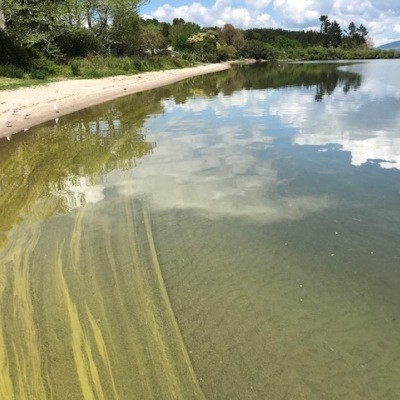Look out for algal blooms

.
If you’re heading out to lakes and rivers across Rotorua and the Bay of Plenty this summer remember to check for algal blooms before going near the water.
“Algal blooms can develop rapidly and unpredictably, and some release toxins which can be very dangerous if you swallow or come into contact with them” says local Medical Officer of Health Dr Gregory Evans, from Health New Zealand | Te Whatu Ora.
Before heading to rivers and lakes people are encouraged to look out for health warnings from www.toiteora.govt.nz/health-warningsand www.lawa.org.nz, and to keep an eye out for signage at recreational water locations.
They should avoid any recreational contact with lakes and rivers if they:
- look discoloured
- have an unusual smell
- have green or brown particles suspended in them, or
- have scum or leathery mats of algae on the surface or on the bottom of the waterway, or along the shoreline.
“Algal bloom toxins can affect your nervous system, causing numbness and tingling round the mouth as well as breathing difficulties, and may spark asthma attacks. They can also cause skin rashes, stomach upsets and visual problems,” said Dr Evans. “If you or your child become unwell after contact with recreational water then call your doctor, or ring Healthline for free on 0800 611 116.”
Algal blooms in lakes are typically free-floating, while those in rivers usually grow in mats attached to rocks at the bottom. These mats can also build up at the shorelines of rivers and lakes, often have a moss-like appearance and are usually a greenish dark brown colour.
“Children playing on the shoreline may accidentally come into contact with these, so it’s important for parents to keep an eye on their kids when visiting rivers and lakes in our region” Dr Evans said.
Dogs should also be kept away from the water if it looks like there may be a bloom, and away from mats which accumulate on the shoreline as they will often eat these. Dogs can become seriously ill if they consume or have contact with toxic algae and need to be taken to the vet immediately if this happens.
Weekly recreational water monitoring testing in the Bay of Plenty has started for the season, led by Bay of Plenty Regional Council.
Health warnings will be issued by the Medical Officer of Health throughout summer when testing shows a site has high levels of blue-green algae.
However, even if no official warning is in place, people still need to be cautious before going into the water.
“Algal blooms are unpredictable and can grow unexpectedly and shift around, especially in lakes” Dr Evans said. “So even if there’s no alert or signage in place, always check first and if the water doesn’t seem right, stay away and stay out.”
Lakes and rivers to be cautious of during summer:
Recreational water sites that most frequently develop toxic algal blooms across the region:
- Lake Rotoehu
- Lake Rotorua
- Lake Okaro
- Lake Rotoiti.